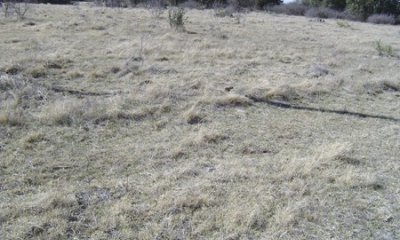
Shallow 26-33" PZ
Scenario model
Current ecosystem state
Select a state
Management practices/drivers
Select a transition or restoration pathway
- Transition T1A More details
- Restoration pathway R2A More details
-
No transition or restoration pathway between the selected states has been described
Target ecosystem state
Select a state
Description
The Midgrass Prairie Community is the interpretive plant community for the site. It was a fire induced midgrass prairie with scattered stands of tallgrasses, scattered woody plants and a good variety of forbs. The tallgrasses usually occurred in the vicinity of limestone outcrops, drainages or the crests of hills. Live oak, hackberry and shrubs were widely scattered in draws. Sideoats grama was the most abundant grass throughout the site. It is estimated that the Midgrass Prairie Community produced from 1500 to 3500 pounds of biomass annually. Grasses make up to 85 percent of species composition.
The Mixed-grass Community (1.2) is mixed-grass dominated grassland being encroached by indigenous or invading woody species. Numerous woody species, including juniper and mesquite, are increasing in density. In this phase, the increasing woody species are generally less than four feet tall and the woody canopy vary between 5 and 20 percent. The prairie becomes grassland being encroached by previously suppressed woody species. The preferred tallgrasses are being replaced by the more grazing resistant midgrasses although little bluestem often persists. Most of the perennial forbs persist, but in lesser amounts, being replaced by weedy forbs. Annual primary production ranges from 1000 to 3000 pounds per acre. Forage production is predominantly grass.
Submodel
State 2
Woodland State



Description
The Mixed-brush/Shortgrass Community (2.1) is characterized by a 20 to 40 percent canopy of woody plants on a shortgrass rangeland. The composition of annual production has shifted toward the woody component. All, except the more palatable woody species, have increased in size and density. Remnants of climax grasses and forbs and unpalatable invaders occupy the open areas between trees and shrubs. Cool-season grasses such as Texas wintergrass can be found under and around woody plants. Annual primary production is approximately 1000 to 2500 pounds per acre.
The Mixed-brush/Shortgrass/Annuals Community (2.2) is open woodland dominated by live oak, mesquite and/or juniper. With continued heavy grazing, the trees and shrubs can approach 70 percent ground cover. Shortgrasses and low quality annual and perennial forbs occupy the woody plant interspaces. Grasses and forbs make up 35 percent or less of the annual forage production. Annual production is 1000 to 2500 pounds per acre.
Submodel
Mechanism
With heavy continuous grazing, no fires, no brush management, and brush invasion, the Grassland State will transition into the Woodland State.
Mechanism
The Woodland State can be restored to the Grassland State with the implementation of various conservation practices such as Prescribed Grazing, Prescribed Burning, Brush Management, and Reclamation.
Relevant conservation practices
| Practice | External resources |
|---|---|
|
Brush Management |
|
|
Prescribed Burning |
|
|
Prescribed Grazing |
|
|
Range Planting |
Model keys
Briefcase
Add ecological sites and Major Land Resource Areas to your briefcase by clicking on the briefcase (![]() ) icon wherever it occurs. Drag and drop items to reorder. Cookies are used to store briefcase items between browsing sessions. Because of this, the number of items that can be added to your briefcase is limited, and briefcase items added on one device and browser cannot be accessed from another device or browser. Users who do not wish to place cookies on their devices should not use the briefcase tool. Briefcase cookies serve no other purpose than described here and are deleted whenever browsing history is cleared.
) icon wherever it occurs. Drag and drop items to reorder. Cookies are used to store briefcase items between browsing sessions. Because of this, the number of items that can be added to your briefcase is limited, and briefcase items added on one device and browser cannot be accessed from another device or browser. Users who do not wish to place cookies on their devices should not use the briefcase tool. Briefcase cookies serve no other purpose than described here and are deleted whenever browsing history is cleared.
Ecological sites
Major Land Resource Areas
The Ecosystem Dynamics Interpretive Tool is an information system framework developed by the USDA-ARS Jornada Experimental Range, USDA Natural Resources Conservation Service, and New Mexico State University.

